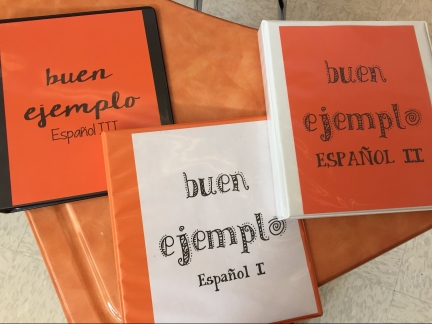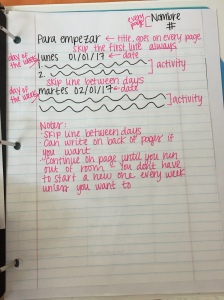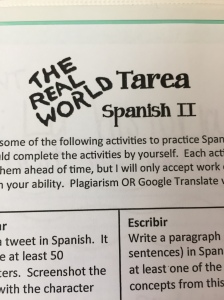For first few posts of Me llamo Profe Hess, I will be describing procedures in my Spanish classes. When I first began teaching (only 4 years ago), I read tons of blogs explaining the importance of establishing procedures at the beginning of the year or semester. However, I couldn’t figure out how to accomplish this. I will be sharing some successful procedures that I use in my Spanish classes. To see the first entry on the Pledge of Allegiance, click here.

The next procedure is near and dear to my heart–binder organization. I know this is a matter of personal preference, but I cannot stand the sight of students wadding up paper and shoving it in backpacks never to be seen again. Therefore, I created, borrowed, and modified a binder organizational system that works for me and my students. The Spanish binder, or carpeta as I call it, has been through many versions; however, this version is here to stay–I think.
The Binder. I require students to have a binder exclusively for Spanish class. I expect them to keep up with all handouts and even retain them from year to year. I also keep an exact copy (buen ejemplo, pictured above) of a student binder for each of my classes. Students use a 1 or 1.5 inch binder, and I keep a supply of extras–most of which have been donated from local businesses. I like for students to have a binder with a front and back outside pocket, so they can store La Promesa and Fast Finisher pages (this will be discussed later). The binder has 3 tab dividers–one for each section.
Units. This is where the bulk of the information for Spanish classes is stored. I divide my curriculum into units. Normally, there are 4 units per semester, so a unit lasts a little more than a month. The first page of a unit is a unit sheet. I print them on colored paper, so students can find the right unit quickly. The unit sheet functions as the table of contents. On the front, students list Puedo (I can) statements that correlate to our daily objectives. On the back, students list the trabajos (assignments) in the order that they are given out.
The unit section is where all of the trabajos, like vocabulary lists, grammar notes, writing activities, are stored. Trabajos are numbered and should be kept in number order. I have found that this simple numbering system helps even the most disorganized student keep things together. This is important because I never make extra copies of anything. Also, I require that students keep up with all trabajos because if it’s important enough for me to create and print it, they should at least not lose it. Additionally, I give binder quizzes (post coming later in the series) at the end of each unit.
Para empezar. The next section of the binder is the para empezar (Bellringer) section. Every day there is a para empezar projected. Students work on this when they enter the classroom, we say La promesa, they sit and finish the para empezar, and we check the answers. Most of the time the para empezar is a review question, but I’ve been known to just ask how was your weekend or something. I’ve found that the consistency is the most important thing. Students know that they will have one every day, and they are expected to be in their seats working when the bell rings. I also randomly check for a particular day’s para empezar and count it as a grade to make sure students are completing them.

RWT. The next section is for RWTs (Real World Tarea). I found this idea on the Creative Language Class and modified it to be what I wanted. RWT will have it’s own post later in this series.

Optional Section–Previous Spanish. For my Spanish II and III classes, I require strongly advise that students keep notes from earlier Spanish classes. This way they can reference notes if they need it. I encourage students to use this section if there is something they don’t quite remember. Some of my students have 1 or 2 years between Spanish I and II–we’re working on this, but it’s hard as a department of one.
What’s your organizational system? Do you have similar requirements?



